Powdery mildew on onions: reasons for the appearance and methods of struggle
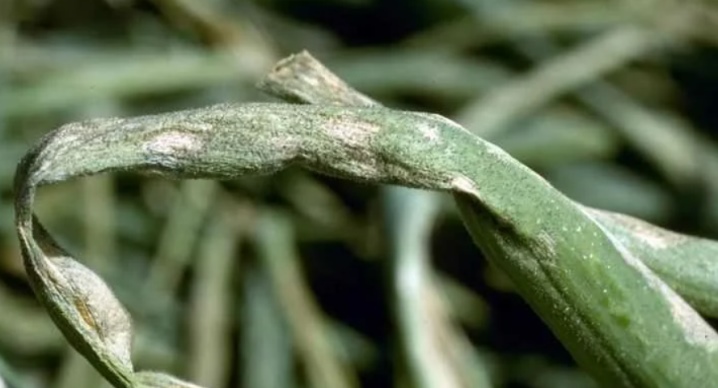
Onions are a cultivated plant widely used by mankind as a means to combat many diseases, but this does not mean that the caustic bulb itself cannot be affected by any disease. Powdery mildew is a serious enemy of gardeners, affecting many cultivated plants, not excluding onions. Accordingly, it is necessary to fight powdery mildew from the moment the first symptoms are detected, otherwise the infection can spread to neighboring crops. At the same time, effective measures taken on time can give the desired result, completely saving crops.
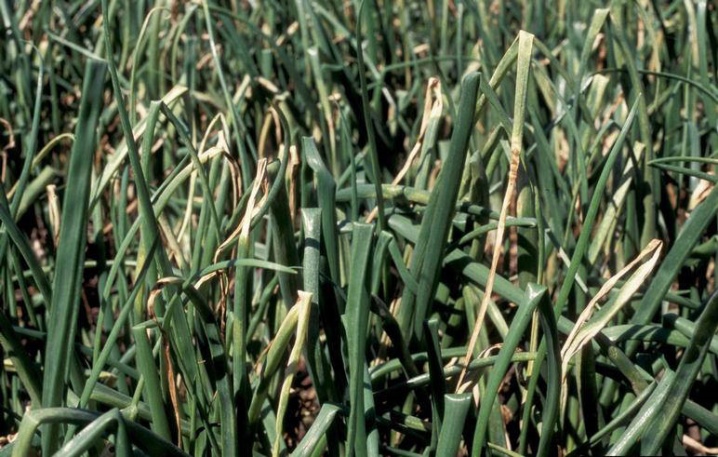
Description of the disease
Powdery mildew has been known to mankind for many centuries, therefore it has a number of alternative, popular names, such as "bel" or "ashstone". In many ways, such names give an idea of what the affected plant looks like - a specific ash-white bloom forms on the onion, which, however, is much more harmful than ordinary ash. In essence, powdery mildew is a fungus that multiplies by spores, which means that it is transmitted between adjacent beds quite quickly.
Curious that there is real powdery mildew, and there is also a false one - another disease, scientifically called peronosporosis. In fact, the ailments are closely related - both are of fungal origin and are accompanied by the same plaque. They differ from each other only in where the mycelium first appears - real powdery mildew appears first from the outside, while the false one originates from the inside.
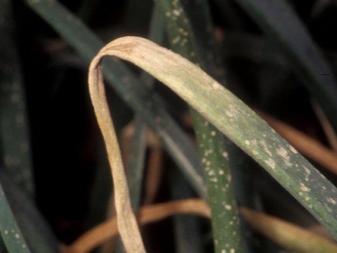
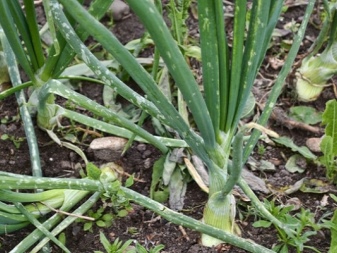
Both types of fungus gradually "eat" the plant, destroying its tissues with their mycelium. The affected leaves cannot perform their own functions normally, therefore they dry out and become covered with yellow spots. The plant, unable to provide the course of photosynthesis, quickly decays, and eventually dies. There can be no question of eating the affected onion leaves - firstly, they do not differ in either an attractive appearance or good taste, and secondly, when stored with healthy leaves, the fungus can spread.
The spread of powdery mildew in a bed of onions or green onions can occur almost instantly., this does not require the confluence of a mass of rare factors. Wind and raindrops are the main "helpers" of spores, transporting them from one plant to another. Moreover, in many cases, the carriers of the infection are the summer residents themselves, who do not follow the basic rules of caring for agricultural plants.
If the transmission has taken place, after just five days, the first signs of the disease can be expected on the newly infected plant.
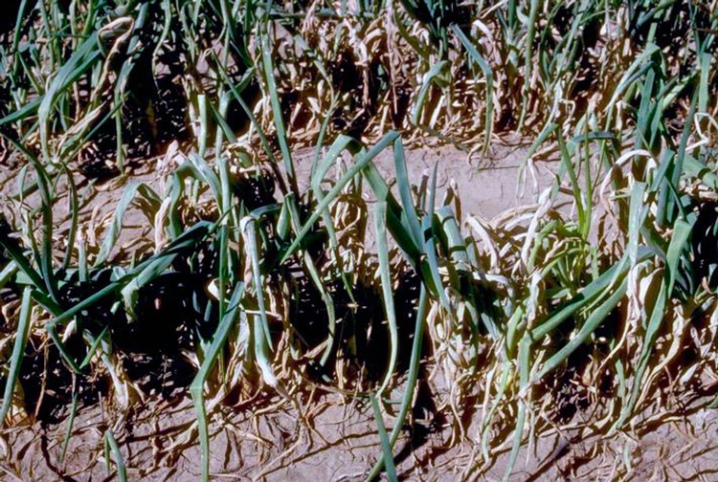
Under what conditions does powdery mildew develop?
Like most fungi, powdery mildew feels great in conditions of low temperatures (approximately 15 degrees Celsius) and high humidity (over 90%). At first glance, in the summer, when the main growing season of the onion passes, such conditions develop quite rarely, which means that the chain of transmission of the disease must often be interrupted, and the pathogen must die in the sun.
And so it happens, but the disease helps out how easily and quickly it spreads from a temporary storage with suitable conditions, as soon as the weather begins to favor it.
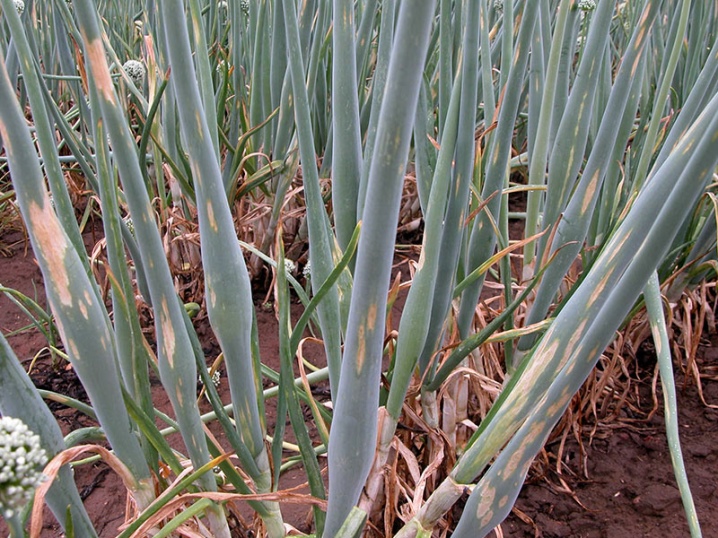
If we talk about specific conditions that additionally contribute to the accelerated transmission of infection from a diseased plant to a healthy one, then first of all the following should be highlighted.
- Abundant sloppy watering. Powdery mildew is perfectly transmitted in the way that in the case of people would be called airborne. When watering, the water washes away the slightest weightless spores of the fungus, and drops, especially in strong winds, can fly away to a distance of up to a meter or more. Because of this spraying, the spread of fungus from one plant throughout the garden is possible almost in one evening.
- Wet weather. We usually do not see this with the naked eye, but humid air contains a huge amount of water suspension - tiny droplets, each of which may contain spores. If, in addition to high humidity, there is also a high temperature, the accumulated moisture helps the powdery mildew to spread at a staggering speed.
- Close landing. Onions are more likely to develop powdery mildew if they are heavily planted. First of all, the two mechanisms described above are triggered: if the distance between neighboring plants is small, the transmission of the disease will occur with an increased probability. In addition, there is no draft in dense plantings - they are not ventilated, which means that the fungus simply has nowhere else to go.
- Increased nitrogen content in the soil. This substance promotes the growth of the fungus, because the more there is, the higher the chances that the pathogen will feel good.
- The vegetable garden is not harvested after harvest. For the fungus, the most difficult time of the year is winter, with its frosts - spores need a secluded place to winter with relative comfort. Such conditions are created by plant debris thrown onto the field, which can maintain an acceptable temperature under a layer of snow.
- Larger pests bring the infection. There are a number of larger living organisms that can carry powdery mildew inside themselves and are also interested in onions. Aphids, nematodes, and onion flies are parasites whose appearance in and of itself is no longer happy, but at the same time they can become harbingers of additional problems.
- Inoculated material. If the spores have survived and survived directly on the seeds, you can plant onions in the beds, which were originally destined to be infected. At the same time, seeds are usually stored in one place in large quantities, and in such storage facilities it is almost impossible to stop the spread of the infection, and the scale of damage will be gigantic.
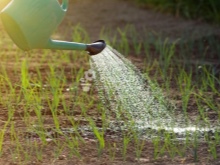
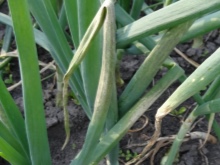
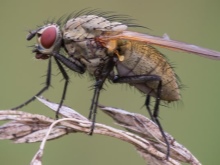
Signs of appearance
If the seeds were infected even before they were planted, the farmer will be able to detect the consequences only after a month, when the onions germinate. It is important to know what powdery mildew looks like in order to determine as early as possible that it has already attacked - this is the only way to take measures so that it does not appear in other plants.
Look for obvious symptoms of the disease on onion feathers. They will look like this:
- specific yellow spots are noticeable on the foliage, the color of which eventually turns into a spider-like gray with the formation of a strange bloom, similar to flour;
- outside of pronounced spots, the leaf also gradually loses its natural green tone, becoming more and more yellow over time;
- initially elastic leaves become lethargic and limp, hang down instead of briskly sticking up, can break under their own weight, and after rain they acquire a purple hue uncharacteristic for onions;
- previously detected gray spots tend to increase their own size;
- the aerial part of the bulb looks more and more depressed, stops growing, the feathers become completely dry;
- damage to the bulb is expressed in its "unwillingness" to grow and ripen, it becomes flabby and colorless;
- onion tops acquire roughness uncharacteristic for a healthy plant, dust and dirt are packed in its irregularities, which is noticeably striking;
- the arrow dries up and becomes brittle;
- the peduncle does not give ripe seeds, the potential seed is immature and unviable.
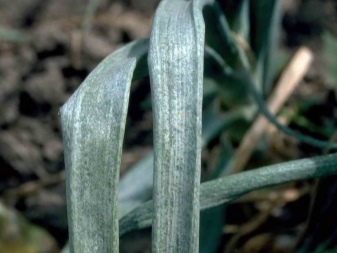

It is best to look for symptoms of fungal infection in the morning while the plant is covered with dew. - during this period, visible violations are especially striking. If the onion has already been harvested, it is difficult to determine by the bulb the fact of its infection from the outside, but it deteriorates under storage conditions under which a normal crop should not deteriorate.
At the slightest suspicion of the presence of an ailment, it is better to dispose of such a crop completely, because the joint storage of diseased bulbs with healthy ones will quickly lead to infection of all specimens.

Control measures
Having noticed the first signs of the appearance of powdery mildew in the garden, something urgently needs to be done - this is the only way to save the crop from complete destruction. Effective treatment of affected plants has not yet been invented - they are so dangerous for all their neighbors that they are immediately removed and burned. It is possible to cure the garden as a whole, but not the plants into which the fungus has already launched its "roots" - unless the disease is detected at a very early stage or the farmer has guessed to spray even the onion that does not yet seem infected with "chemistry".
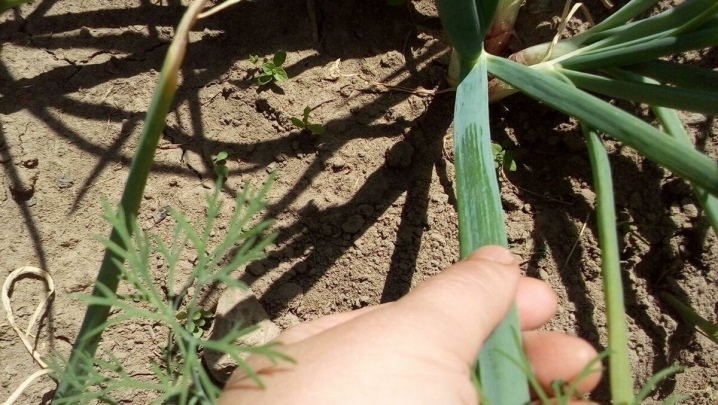
Special drugs
A one-time treatment of potentially infected plants with chemical preparations will most likely not provide an obvious result - simply because the infection is able to "sit out" inside the bulb, quickly recovering in quantity after the cessation of the "chemistry". It will be a little more beneficial if you treat diseased plants several times.
The following drugs are considered the most popular store-bought remedies to help fight powdery mildew.
- "Arcerid". A brown powder, a solution of which (30 grams of dry matter per bucket of water) should be watered on infected plants. The procedure must be repeated every 2 weeks.
- "Polycarbacin". Assumes a processing method similar to the one described above, but the proportion for preparing the solution is different - 40 grams per bucket of water.
- "Kurzat". The preparation with copper oxychloride in the composition has a complex effect, fighting not only fungi, but also bacteria, but it is used only for young plants. For 10 liters of water, 60 grams of the drug is needed.
- Thanos. Two-component product with a well-defined period of use - the bulb must release 5 leaves to be applied.
- Fitosporin. One of the most famous drugs, which has shown itself well in the fight against the enemy. Differs in economical consumption - only 20 ml of substance is needed for 10 liters of water.
- "Urea". A reliable product used in the proportion of 30 grams per bucket of water.
- "Topaz". The drug is in ampoules, the use of which is appropriate even in the early stages of the development of the disease. Helps to heal onions, which in another situation would have given up. One ampoule is dissolved in 10 liters of liquid.
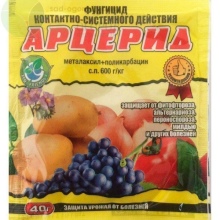
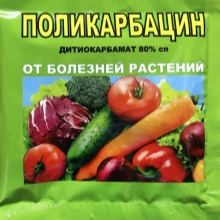
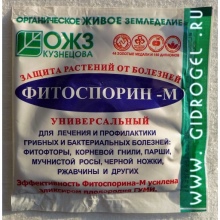
Having chosen a specific drug, it is necessary to read in detail the instructions for it - it is usually not recommended to spray more often than 3-4 times per season with a time interval of 2 weeks. 15-20 days before harvesting, any spraying stops altogether - at least, the onions sprayed during this time can no longer be eaten.
Traditional methods
People fought against powdery mildew long before the emergence of a developed chemical industry, and folk methods of getting rid of the fungus are still quite popular. The reasons for this lie on the surface - first, you do not need to go to the store and spend money for the remedy, since you can make it yourself from improvised ingredients, and secondly, all homemade preparations are safer for humans. The second advantage of folk remedies is at the same time their disadvantage: they are less dangerous not only for humans, but also for the fungus itself, which means that they may not show proper effectiveness.
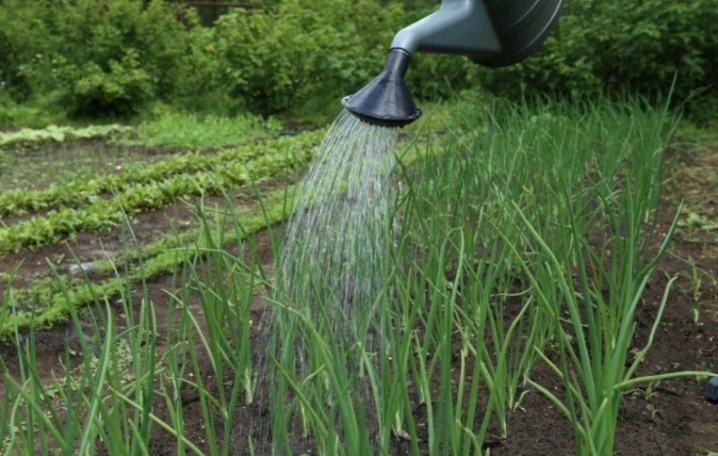
Here are the most famous folk recipes that allow you to get a healthy harvest without the use of harmful "chemicals".
- Soaking in a solution of potassium permanganate. This method is unlikely to be useful for saving whole plants, but it does decontaminate the harvested bulbs so that they can be safely stored with a non-contaminated crop. The solution is prepared according to the proportion according to which 10 grams of potassium permanganate is dissolved in a liter of water. The onion is kept in the resulting liquid for 45 minutes.
- Soda ash. The principle of processing is similar to the one described above, only instead of potassium permanganate, we will treat the onion with soda. You only need one spoonful of it for a bucket of water.
- Wood ash. Another substance, the preparation of a solution on the basis of which consists of two stages. 2 glasses of ash are first diluted and insisted in a small amount of boiling water so that the liquid absorbs as many active elements as possible, and only then they are dissolved in more water - about one bucket for the same 2 glasses of ash. Unlike the recipes described above, the bulbs are not soaked in such a solution - they are treated with the soil in the garden.
- Copper sulfate solution. 10 grams of the proposed substance is dissolved first in 500 ml of hot water, and only then the resulting solution is poured into a bucket of cool water. To enhance the effect, you can also add laundry soap to the liquid, after which the slightly affected (and looking healthy) leaves are wiped with the solution. Such a preventive measure is carried out up to four times a month and is considered relatively gentle.
- Iodine tincture. The last recipe on our list is effective the first moment after the disease is detected. Dissolve 10 ml of ordinary pharmaceutical iodine in a bucket of water. The improved formulation also implies the addition of 3 liters of whey - the bacteria present in sour milk help suppress the activity of fungal spores. Foliage is treated with such compositions, regardless of whether damage is visible on it.

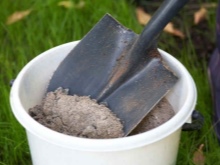

Prophylaxis
The best defense against powdery mildew is a retaliatory attack on it, because experienced farmers prefer not to wait for the fungus to manifest itself, but to rely on preventive measures. By following some simple rules, you can significantly reduce the need to use "chemistry". These are the rules:
- powdery mildew is best transmitted between closely related plant species, therefore, it is necessary to adhere to an elementary crop rotation and not plant onions in a garden bed that was previously occupied with garlic, shallots or batun;
- preliminary disinfection of the seed before planting, even if there is no suspicion about its contamination, greatly increases the chances that the plants in the garden will initially be healthy;
- it is necessary to keep order in the beds, thinning them out and removing weeds in a timely manner, because in them the fungus can "sit out" and re-attack the cultivated plants already treated with antifungal agents;
- the used agricultural tool should be disinfected twice - both before starting work and after its completion;
- it is most reasonable to water the onion in the morning - this contributes to the fastest drying of the surface of its leaves and reduces the rate of spread of harmful spores;
- cabbage and cucumbers are least vulnerable to the action of powdery mildew - plant a crop where these vegetables used to grow;
- well-lit areas heated by the sun are unfavorable for the development and rapid spread of powdery mildew, therefore, onions should be planted in places with such conditions;
- autumn digging with thorough deepening helps to ensure that fewer pests and pathogens remain in the soil;
- nitrogen fertilizers contribute to the growth of the fungus, you should be careful with them - instead, use mineral fertilizers, the main minerals of which are phosphorus and potassium.
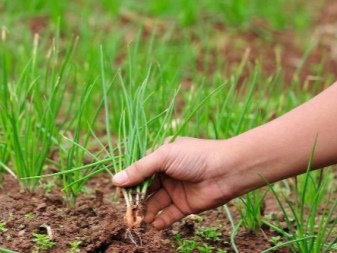
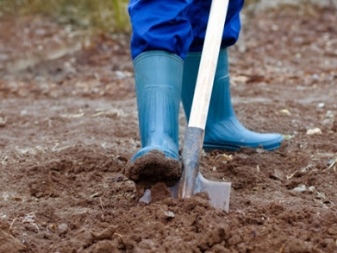
For information on how to process onions from powdery mildew, see below.













The comment was sent successfully.